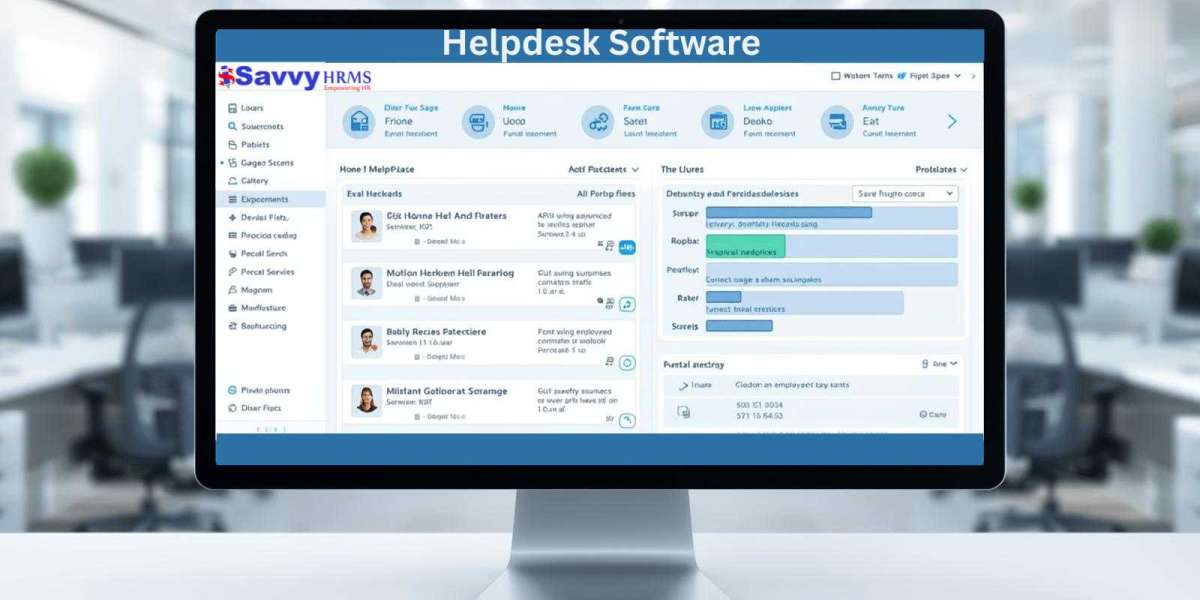Let’s start with a truth we’ve all lived through: when customers, employees, or vendors reach out with issues, the real chaos begins. Emails pile up, messages flood in, and every department scrambles to remember who’s supposed to fix what. Somewhere in that mess, a few problems fall through the cracks. Sound familiar?
That chaos is the reason helpdesk software has become one of the most transformative tools for modern organizations. It isn’t just about logging tickets or assigning tasks it’s about bringing order, clarity, and measurable improvement to every support process in your business.
If you’ve ever wondered why companies that once relied on spreadsheets or endless email threads suddenly swear by helpdesk systems, this guide is for you. Let’s explore why helpdesk software is no longer optional, how it actually works, and how it can redefine your organization’s efficiency from the inside out.
What Exactly is Helpdesk Software?
Helpdesk software is a digital command center for all your support activities. It’s where customer queries, employee issues, vendor requests, and internal service demands are logged, tracked, and resolved.
Instead of juggling messages across emails, chat threads, or sticky notes, helpdesk software lets you manage everything in one centralized system. You can create tickets, assign them to departments, set priorities, monitor progress, enforce service-level timelines, and analyze performance all from a single dashboard.
Think of it as the brain of your support operation. Every query becomes a trackable task with ownership, accountability, and a clear timeline. And unlike traditional manual methods, nothing slips through the cracks.
Why Every Business Big or Small Needs Helpdesk Software
There’s a dangerous assumption many leaders make: “We’re small, we can manage support manually.” That might work for ten tickets a week. But the moment your business scales, so does the complexity.
Without helpdesk software, here’s what happens behind the scenes:
Teams lose visibility into which requests are pending or who’s working on what.
Customers and employees keep following up because they have no update on their issues.
Managers can’t track how efficiently their teams are resolving problems.
Departments end up blaming each other for delays.
Your overall productivity and your brand reputation takes a hit.
Now flip that scenario. With the right helpdesk system in place, every ticket is visible, tracked, prioritized, and reported. Issues are categorized, agents are accountable, and customers get quick responses.
That’s not just support management that’s operational excellence.
How Helpdesk Software Works Behind the Scenes
Let’s walk through the mechanics of how a good helpdesk system turns chaos into calm.
1. Ticket Creation
Every support request whether through email, a web form, or a chat tool is automatically converted into a digital ticket. Each ticket is tagged with a unique ID, making it traceable from start to finish.
Users can select the category of their issue, attach supporting documents, and mark priority levels like urgent, high, medium, or low. This ensures clarity right from the start.
2. Ticket Assignment and Routing
Once a ticket is created, it doesn’t just float around. The software intelligently routes it to the right department or agent based on predefined rules. For example, IT-related issues go to the tech team, HR queries go to the HR desk, and facility requests go to admin.
Routing rules can be automated, ensuring zero manual dependency and faster responses.
3. Workflow Management and Escalations
The system automatically tracks the ticket’s journey from “New” to “In Progress,” “Resolved,” or “Closed.”
If a ticket remains unattended for too long or misses an SLA (Service Level Agreement), the system triggers alerts or escalations. This keeps everyone accountable and ensures no issue is ignored.
4. Collaboration and Communication
Agents can comment, tag colleagues, upload files, and communicate directly within the ticket itself. No more switching between chat apps, emails, or calls.
Meanwhile, users are kept in the loop through automated updates and notifications. Transparency builds trust both internally and externally.
5. Reporting and Analytics
This is where the magic really happens. Helpdesk software provides data-rich dashboards that show key metrics like:
Number of open vs. closed tickets
Average resolution time
SLA compliance rate
Ticket ageing reports
Department performance
Most common issue categories
These insights help you identify bottlenecks, balance workloads, and continuously improve support quality.
Core Features That Make Helpdesk Software Indispensable
When choosing a helpdesk system, you’re not just buying a tool you’re investing in a framework for better business performance. The right system will offer:
Customizable Categories: Define your own departments, issue types, and subcategories to fit your workflow.
Role-Based Access: Assign roles with specific permissions so everyone sees only what they need to.
Priority Management: Categorize tickets by urgency to ensure critical issues are addressed first.
Seamless Transfers: Allow cross-department ticket transfers with full visibility and history.
Automation and Alerts: Set triggers for repetitive tasks, reminders, and follow-ups.
Centralized Dashboard: One unified interface for every ticket and every metric.
Cloud Access: Support hybrid or remote teams with anytime, anywhere accessibility.
Comprehensive Reporting: Turn raw data into actionable insights with visual analytics.
These features don’t just make your support system faster they make it smarter.
Top Benefits of Implementing Helpdesk Software
Still wondering if it’s worth it? Here are the real, measurable benefits that organizations experience once they implement a proper helpdesk system.
1. Reduced Response Time
Automation and smart routing ensure the right people see the right requests immediately. That means faster fixes and happier users.
2. Improved Productivity
No more time wasted digging through old messages or duplicated efforts. Every agent knows their tasks, priorities, and deadlines.
3. Enhanced User Satisfaction
Whether it’s a customer or an employee, everyone loves clarity. They can log requests, track status, and receive updates without chasing anyone.
4. Centralized Knowledge
Tickets and their solutions become a permanent knowledge base for future reference. This reduces repeat queries and improves consistency.
5. Accountability and Transparency
Every action is recorded. You know who handled what, when, and how. That transparency strengthens teamwork and discipline.
6. Data-Driven Decision Making
With real-time analytics, you can identify trends, recurring problems, and performance gaps. That’s gold for continuous improvement.
7. Scalability Without Chaos
As your business grows, the system grows with you. Add users, departments, and workflows without losing control.
Common Mistakes to Avoid During Implementation
Even great software can fail if implemented poorly. Watch out for these common traps:
Skipping Workflow Mapping: Define your process before going live. Know who handles what.
Poor Categorization: Don’t lump all tickets together. Clear categories mean clear reporting.
Lack of User Training: If employees don’t know how to raise or track tickets, adoption will fail.
No Reporting Framework: Dashboards should be configured from day one.
Unrealistic SLAs: Start with achievable goals, then tighten them as you grow.
Neglecting Feedback: Encourage users to share their experience. That’s how you improve usability.
When Should You Introduce Helpdesk Software?
There’s no “perfect” time, but here are the signs you should take the leap:
Your team handles more than 20 support requests a week.
You regularly lose track of pending issues.
Employees or customers complain about delayed responses.
You can’t measure the performance of your support team.
Internal communication feels like a game of broken telephone.
If even one of those points feels familiar, you’re ready for a helpdesk system.
Steps to Successfully Deploy Helpdesk Software
Audit Your Current Process: Identify where tickets are getting lost.
Define Workflows: Outline how requests should move from start to finish.
Select the Right Tool: Choose a flexible, scalable system that matches your company’s workflow.
Configure Departments and Roles: Set up categories, permissions, and routing rules.
Train Teams: Teach users how to raise, track, and resolve tickets efficiently.
Go Live with a Pilot Run: Start small, then expand.
Measure, Improve, Repeat: Track key metrics like response time, closure rate, and SLA performance.
With consistent monitoring and feedback loops, your helpdesk system will quickly evolve into a backbone of operational excellence.
The Future of Helpdesk Software
Helpdesk systems are getting smarter every day. The new generation of tools are equipped with AI-driven automation, chatbots, predictive routing, and voice-assisted ticket management. Imagine a world where:
Tickets auto-route to the best agent based on expertise.
Repetitive questions are handled by an intelligent virtual assistant.
Reports are generated automatically with actionable insights.
Agents collaborate through integrated communication tools.
That’s where the future is heading and early adopters will gain the edge in customer satisfaction and cost efficiency.
Conclusion: Transform Support into a Strength, Not a Struggle
Your support system is a mirror of your organization’s efficiency. If it’s scattered, untracked, and reactive, it reflects poorly on your brand. But if it’s streamlined, transparent, and data-driven, it becomes a competitive advantage.
Helpdesk software gives you that edge. It centralizes operations, builds accountability, accelerates response times, and enhances satisfaction for every stakeholder whether internal or external.
In a world where time and reputation matter equally, this is one investment you can’t afford to postpone. The longer you wait, the more inefficiency compounds.
So take the first step today. Modernize your support operations, empower your teams, and deliver the kind of experience your users deserve.
Book a Free Demo today and discover how helpdesk software can simplify your support operations, enhance productivity, and create a smoother experience for everyone involved.














